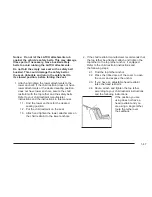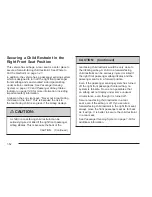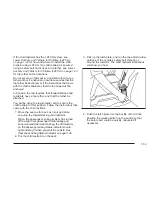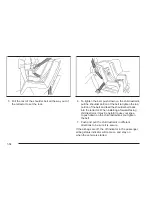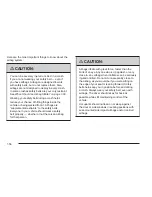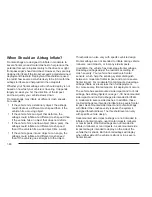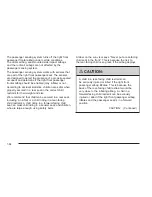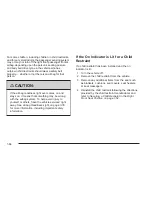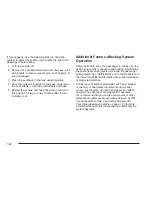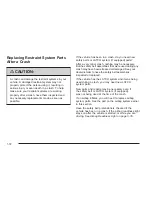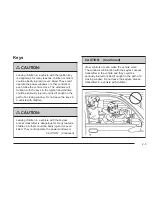
When Should an Airbag Inflate?
Frontal airbags are designed to inflate in moderate to
severe frontal or near-frontal crashes to help reduce the
potential for severe injuries mainly to the driver’s or right
front passenger’s head and chest. However, they are only
designed to inflate if the impact exceeds a predetermined
deployment threshold. Deployment thresholds are used
to predict how severe a crash is likely to be in time for the
airbags to inflate and help restrain the occupants.
Whether your frontal airbags will or should deploy is not
based on how fast your vehicle is traveling. It depends
largely on what you hit, the direction of the impact,
and how quickly your vehicle slows down.
Frontal airbags may inflate at different crash speeds.
For example:
•
If the vehicle hits a stationary object, the airbags
could inflate at a different crash speed than if the
vehicle hits a moving object.
•
If the vehicle hits an object that deforms, the
airbags could inflate at a different crash speed than
if the vehicle hits an object that does not deform.
•
If the vehicle hits a narrow object (like a pole), the
airbags could inflate at a different crash speed
than if the vehicle hits a wide object (like a wall).
•
If the vehicle goes into an object at an angle, the
airbags could inflate at a different crash speed
than if the vehicle goes straight into the object.
Thresholds can also vary with specific vehicle design.
Frontal airbags are not intended to inflate during vehicle
rollovers, rear impacts, or in many side impacts.
In addition, the vehicle has dual-stage frontal airbags.
Dual-stage airbags adjust the restraint according to
crash severity. Your vehicle has electronic frontal
sensors, which help the sensing system distinguish
between a moderate frontal impact and a more severe
frontal impact. For moderate frontal impacts, dual-stage
airbags inflate at a level less than full deployment.
For more severe frontal impacts, full deployment occurs.
The vehicle has seat-mounted side impact and roof-rail
airbags. See Airbag System on page 1-55. Seat-mounted
side impact and roof-rail airbags are intended to inflate
in moderate to severe side crashes. In addition, these
roof-rail airbags are intended to inflate in a severe frontal
impact. Seat-mounted side impact and roof-rail airbags
will inflate if the crash severity is above the system’s
designed threshold level. The threshold level can vary
with specific vehicle design.
Seat-mounted side impact airbags are not intended to
inflate in frontal impacts, near-frontal impacts, rollovers,
or rear impacts. Roof-rail airbags are not intended to
inflate in rollovers or rear impacts. A seat-mounted side
impact airbag is intended to deploy on the side of the
vehicle that is struck. Both roof-rail airbags will deploy
when either side of the vehicle is struck or in a severe
frontal impact.
1-60
Содержание 2009 CTS
Страница 6: ...NOTES vi...
Страница 146: ...NOTES 2 68...
Страница 149: ...NOTES 3 3...
Страница 150: ...Instrument Panel Overview CTS Shown CTS V Similar 3 4...
Страница 178: ...United States V Series Automatic Transmission Cluster shown Manual and Canada similar 3 32...
Страница 322: ...CTS V When you open the hood on the 6 2L Super Charged engine you will see the following 5 16...
Страница 434: ...Relays Usage FUEL PUMP Fuel Pump LCK Lock Relays Usage LT POS LP Left Position Lamp REAR FOG Not Used 5 128...
Страница 457: ...Engine Drive Belt Routing CTS CTS V 6 17...
Страница 459: ...Maintenance Record cont d Date Odometer Reading Serviced By Maintenance Stamp Services Performed 6 19...
Страница 460: ...Maintenance Record cont d Date Odometer Reading Serviced By Maintenance Stamp Services Performed 6 20...


